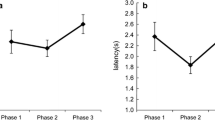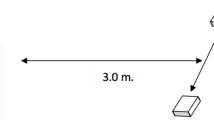Abstract
When interacting with others, informants may offer conflicting information or information of varying accuracy. Recent research suggests that young children do not trust all informants equally and are selective in both whom they solicit for information and whose claims they support. We explored whether domestic dogs (Canis familiaris) are similarly sensitive to agreement among informants. To this end, we utilized a common human gesture, pointing, to which recent research suggests dogs are sensitive. We conducted two experiments in which an experimenter secretly hid food in one of two clear containers while the dog was distracted. Next, a small group moved to indicate the food’s location using stationary points positioned above the containers. In Experiment 1, two experimenters moved to stand behind the non-baited container, while a third experimenter moved to stand behind the baited container. Then, all directed one static point at the container in front of them. Experiment 2 exactly resembled Experiment 1 with the exception that the single experimenter standing behind the baited container directed two static points at the container (one with each hand). Dogs chose the container indicated by the majority in Experiment 1 significantly more often than chance, but chose the container indicated by the minority in Experiment 2 significantly more often than chance. This suggests that the number of points, not the number of people, more strongly influenced dogs’ choices.
Similar content being viewed by others
References
Asch SE (1956) Studies of independence and conformity: 1. A minority of one against a unanimous majority. Psychol Monogr 70(9):1–70
Birch SAJ, Vauthier SA, Bloom P (2008) Three and 4-year-olds spontaneously use others’ past performance to guide their learning. Cogn 107:1018–1034
Corriveau KH, Harris PL (2010) Preschoolers (sometimes) defer to the majority in making simple perceptual judgments. Dev Psychol 46:437–445
Corriveau KH, Fusaro M, Harris PL (2009) Going with the flow: preschoolers prefer nondissenters as informants. Psychol Sci 20:372–377
Couillard N, Woodward A (1999) Children’s comprehension of deceptive points. Br J Dev Psychol 17:515–521
De Los Reyes A (2011) Introduction to the special section. More than measurement error: discovering meaning behind informant discrepancies in clinical assessments of children and adolescents. J Clin Child Adolsc Psychol 40:1–9
Dorey NR, Udell MR, Wynne CL (2009) Breed differences in dogs’ sensitivity to human points: a meta-analysis. Behav Process 81:409–415. doi:10.1016/j.beproc.2009.03.011
Fiset S, Beaulieu C, Landry F (2003) Duration of dogs’ (Canis familiaris) working memory in search for disappearing objects. Anim Cogn 6:1–10
Fusaro M, Harris PL (2008) Children assess informant reliability using bystanders’ non-verbal cues. Dev Sci 11:781–787
Harris PL, Pasquini ES, Duke S, Asscher JJ, Pons F (2006) Germs and angles: the role of testimony in young children’s ontology. Dev Sci 17:757–758
Haun DM, Tomasello M (2011) Conformity to peer pressure in preschool children. Child Dev 82:1759–1767
Kundey SMA, De Los Reyes A, Arbuthnot J, Allen R, Coshun A, Molina S, Royer E (2010) Domesticated dogs’ (Canis familiaris) response to dishonest human points. Int J of Compar Psychol 23:201–215
Miklósi Á, Polgárdi R, Topál J, Csányi V (1998) Use of experimenter-given cues in dogs. Anim Cogn 1:113–121
Osthaus B, Lea SEG, Slater AM (2005) Dogs (Canis lupis familiaris) fail to show understanding of means end connections in a string pulling task. Anim Cogn 8:37–47
Petter M, Musolino E, Roberts WA, Cole M (2009) Can dogs (Canis familiaris) detect human deception? Behav Process 82:109–118
Sherif M (1936) The psychology of social norms. Harper, New York
Topál J, Byrne R, Miklósi A, Csányi V (2006) Reproducing human actions and action sequences: “Do as I do!” in a dog. Anim Cogn 9:355–367
Acknowledgments
We would like to thank Sabrina Molina, Kathy Ford, Weston Dennen, Blair Starnes, and Erica Royer for their assistance in data collection and participant recruitment.
Author information
Authors and Affiliations
Corresponding author
Rights and permissions
About this article
Cite this article
Kundey, S.M.A., German, R., De Los Reyes, A. et al. Domestic dogs’ (Canis familiaris) choices in reference to agreement among human informants on location of food. Anim Cogn 15, 991–997 (2012). https://doi.org/10.1007/s10071-012-0525-7
Received:
Revised:
Accepted:
Published:
Issue Date:
DOI: https://doi.org/10.1007/s10071-012-0525-7




